ISSN ONLINE(2319-8753)PRINT(2347-6710)
ISSN ONLINE(2319-8753)PRINT(2347-6710)
A. Suribabu1, Dr U.Rangaraju 2, Dr.M. Ravindra Krishna3
|
| Related article at Pubmed, Scholar Google |
Visit for more related articles at International Journal of Innovative Research in Science, Engineering and Technology
River sand is most commonly used fine aggregate in the production of concrete poses the problem of acute shortage in many areas. Quarry rock dust can be an economic alternative to the river sand. Quarry Rock Dust as 100% substitutes for Natural Sand in concrete. Mix design has been developed for M25 and M40 grades using design approach IS for both conventional concrete and quarry dust concrete. Tests were conducted on cubes and beams to study the strength of concrete made of Quarry Rock Dust and the results were compared with the Natural Sand Concrete. It is found that the compressive and flexural strength of concrete made of Quarry Rock Dust are nearly 10% more than the conventional concrete. Tests were also conducted on cubes and beams which are exposed to temperatures of 300°C for 1hr, 3hr durations respectively
Keywords |
| Quarry Rock Dust, M25 and M40 grades, Sand Concrete, flexural strength etc,. |
INTRODUCTION |
| To meet the requirements of globalization, in the construction of buildings and other structures concrete plays the rightful role and a large quantum of concrete is being utilized. River sand, which is one of the constituents used in the production of conventional concrete, has become highly expensive and also scarce. In the backdrop of such a bleak atmosphere, there is large demand for alternative materials from industrial waste. |
II. LITERATURE SURVEY |
| 1. Mahendrana et al studied on feasibility of the usage of Quarry Rock Dust as hundred percent substitutes for Natural Sand in concrete. It is found that the compressive, flexural strength and Durability Studies of concrete made of Quarry Rock Dust are nearly 10% more than the conventional concrete. |
| 2. Kathirvel. P et al studied the Durability of SCC with Partial replacement of cement by Quarry and limestone (dust) Powder by (10%, 20%, and 30%) and comparing the properties like Density Variation, Compressive Strength, Water Sorptivity for 28, 60, 90 and 120 Days age with respect to control SCC. |
| 3. Santhosh Kumar.P.T et al made an attempt to study the effect of type of fine aggregate on the 28 day compressive strength of concrete. The result of the investigation indicate that the ratio of the 28 day compressive strength of concrete with crushed stone sand to that of river sand is 1.06 with a coefficient of variation of 11 %. |
III. EXPERIMENTAL INVESTIGATION |
2.1 Quarry rock dust |
| The Quarry Rock Dust obtained from local resource Sri Kanaka Durga Fal-G Brick products, Visakhapatnam was used in concrete to cast test cubes and beams. The physical and chemical properties of Quarry Rock Dust obtained by testing the samples as per Indian Standards are listed in Tables 1 and 2, respectively. |
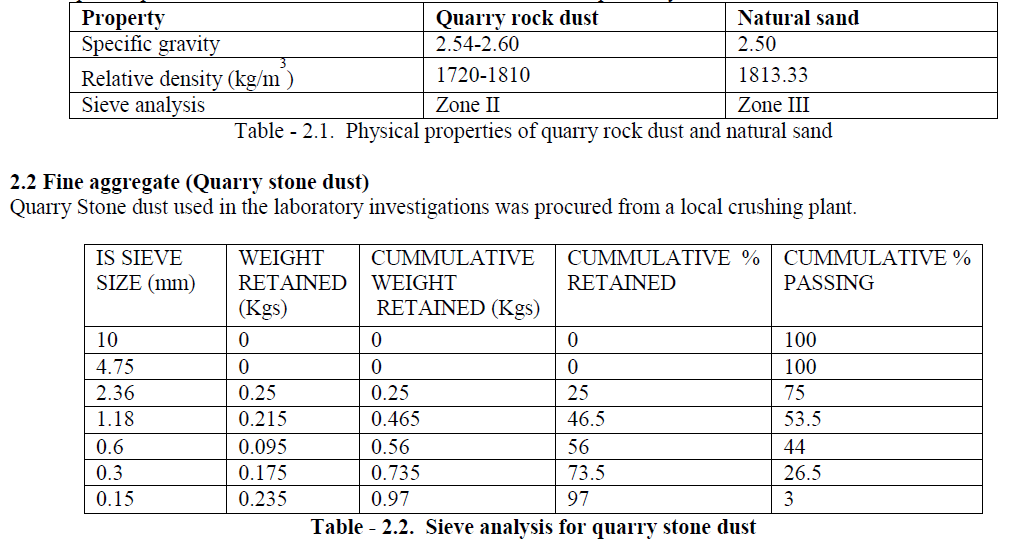 |
| The specific gravity of stone dust was 2.63 and fineness modulus was 2.67 |
| Super plasticizers are usually highly distinctive in their nature, and they make possible the production of concrete which, in its fresh or hardened state, is substantially different from concrete made using water-reducing admixtures. |
| Conplast SP430 disperses the fine particles in the concrete mix, enabling the water content of the concrete to perform more effectively. The very high levels of water reduction possible allow major increases in strength to be obtained. |
| Conplast SP430 is compatible with other types of Forsook admixtures when added separately to the mix. Site trials should be carried out to optimise dosages. Cohesion is improved due to dispersion of cement particles thus minimising segregation and improving surface finish. |
2.3 TEST SPECIMENS PREPARATION |
| The 150 mm size concrete cubes, concrete beams of size 100 mm x 100 mm x 500 mm were used as test specimens to determine the compressive strength and flexural strength respectively. The specimens were cast for M25, and M40 grade and for coarse aggregates of size 20 mm was used. The workability of fresh concrete was measured in terms of slump values. To obtain the required slump value super plasticiser (1.0%, 1.3% and 1.6 % of weight of cement) is added. The ingredients of concrete were thoroughly mixed till uniform consistency was achieved. The cubes and beams were compacted on a vibrating table. |
2.4 Mix Design for M25-Grade Concrete |
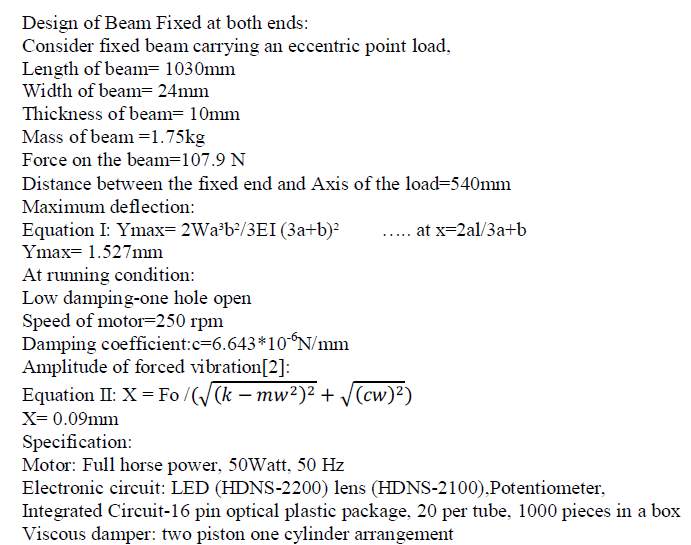 |
 |
| The above mix designs are used for casting concrete specimens. The water-cement ratio changes for different dosages of super plasticiser. Usage of super plasticiser reduces the water requirement and new w/c ratios are obtained. The following tables show the details of w/c ratios obtained at various dosages of super plasticiser for M25 and M40 concrete. |
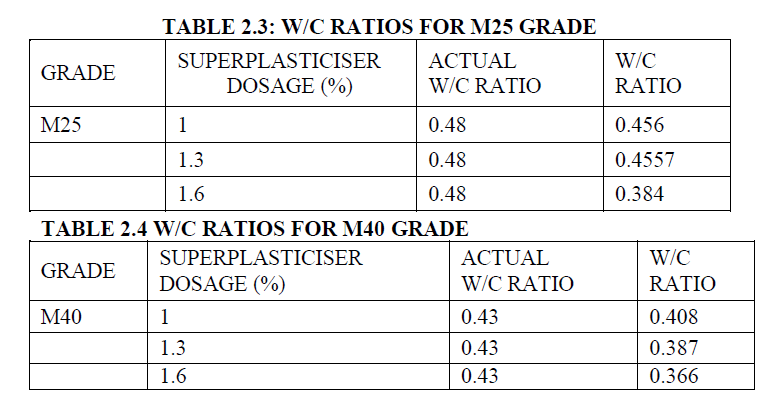 |
2.6 PREPARATION OF TESTING SPECIMEN: |
2.6.1 CASTING OF THE SPECIMENS: |
| The present experimental work includes casting and testing of specimens to know the compressive strength and flexural strength of cubes and beams. These concrete cubes and beams are casted and tested as per IS 516-1959 specifications. |
| The specimens are casted for the following: |
| 1. M25 grade concrete with OPC+NATURAL SAND |
| 2. M25 grade concrete with OPC + QUARRY STONE DUST |
| 3. M40 grade concrete with OPC+NATURAL SAND |
| 4. M40 grade concrete with OPC + QUARRY STONE DUST |
2.6.2 COMPACTION OF CONCRETE: |
| Compaction of concrete is the process adopted for expelling the entrapped air from the concrete. In the process of placing and mixing of concrete, air is likely to get entrapped in the concrete. If air is not removed fully, the concrete loses strength considerably. In order to achieve full compaction and maximum density Table vibrator is used in this experiment. |
2.7 RESULTS |
| In order to study the strength behaviour and fire resistance of the concrete made with full replacement of sand with Quarry stone dust the tests are conducted. Results so obtained for the tests conducted on cubes and prisms for M25 and M40 grades of concrete with various dosages of super plasticiser at 7days and 28 days were tabulated. The results were compared for concretes with natural sand to that of quarry stone dust as fine aggregate. |
2.7.1 COMPRESSIVE STRENGHTS (M25 GRADE): |
| The compressive strength of M25 grade concrete cubes made with natural sand and those made with quarry stone dust as fine aggregate are tested under compression testing machine and results are tabulated in table shown below |
 |
| From the table it is observed that both the concretes are achieving the target strengths at the age of 28 days. But the compressive strengths of normal concrete are slightly higher when compared with Quarry stone dust concrete. There is no significant difference in the strengths with variation in dosage of super plasticiser. The following figures give an idea regarding compressive strengths |
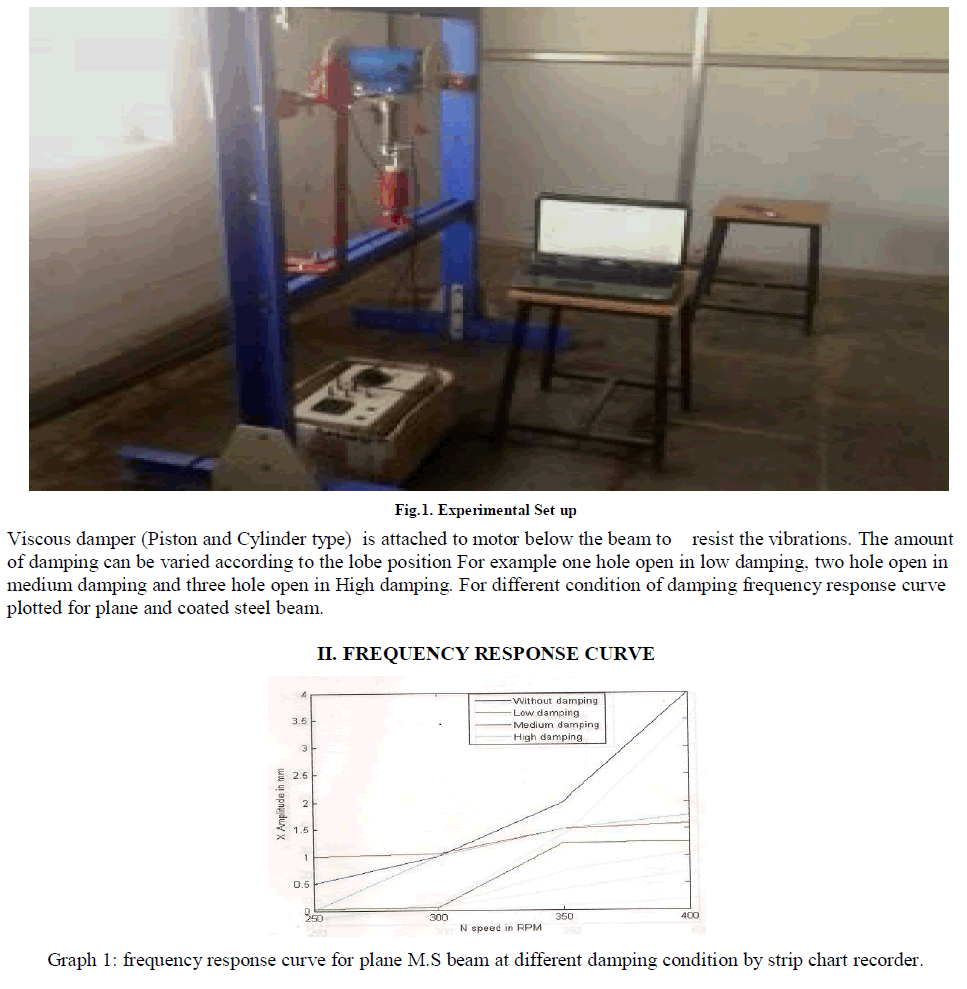 |
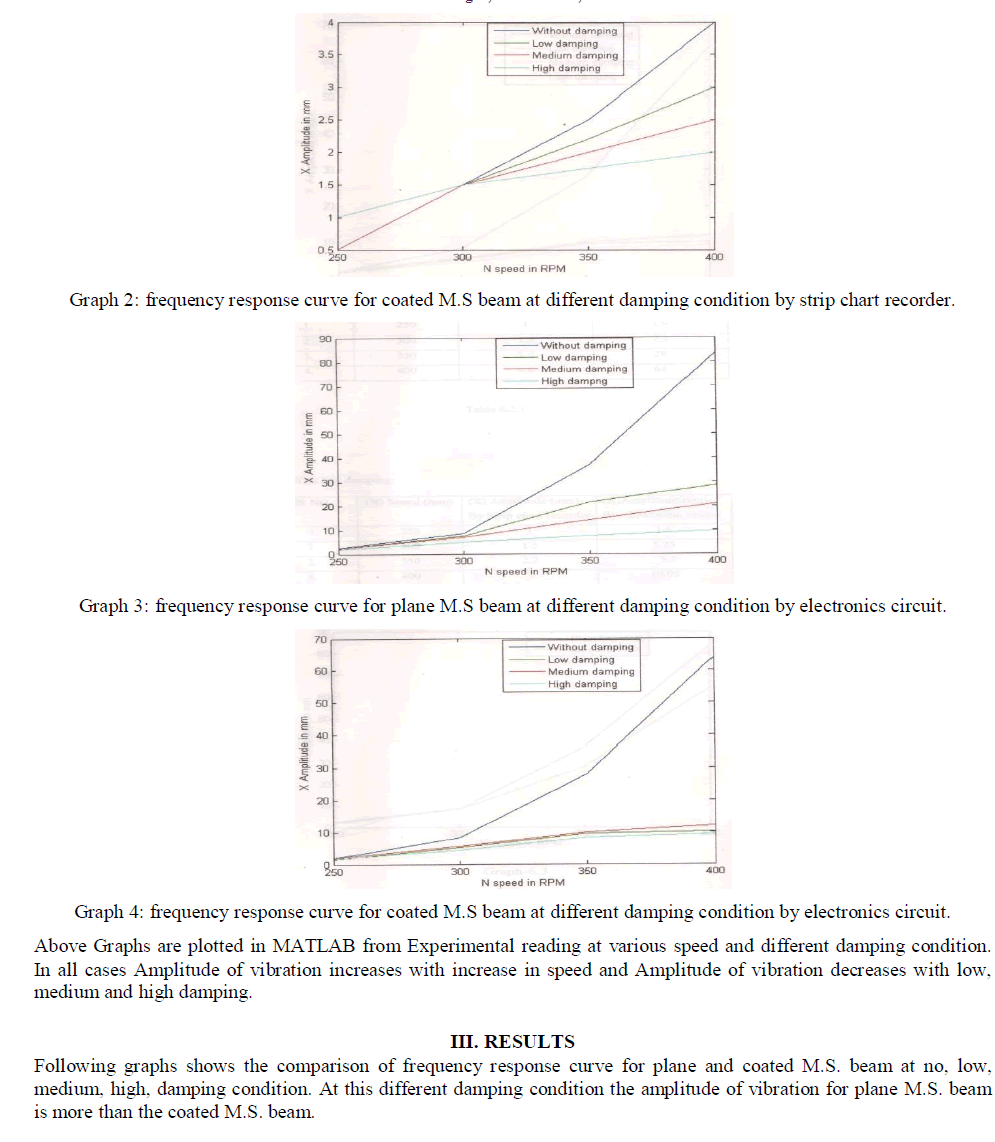 |
2.7.2 TEMPERATURE: |
| The test results of M25 grade cubes which are exposed to a temperature of 300°C in furnace for 1hour and 3hr durations are tabulated below: |
 |
 |
| From the results it is observed that the percentage reduction of weight of specimen after taking out from the furnace varies between 3% and 4%. In both the types of concrete it observed that with the increase duration of heating the compressive strengths are decreasing. The following figure shows the strength variation with temperature duration. |
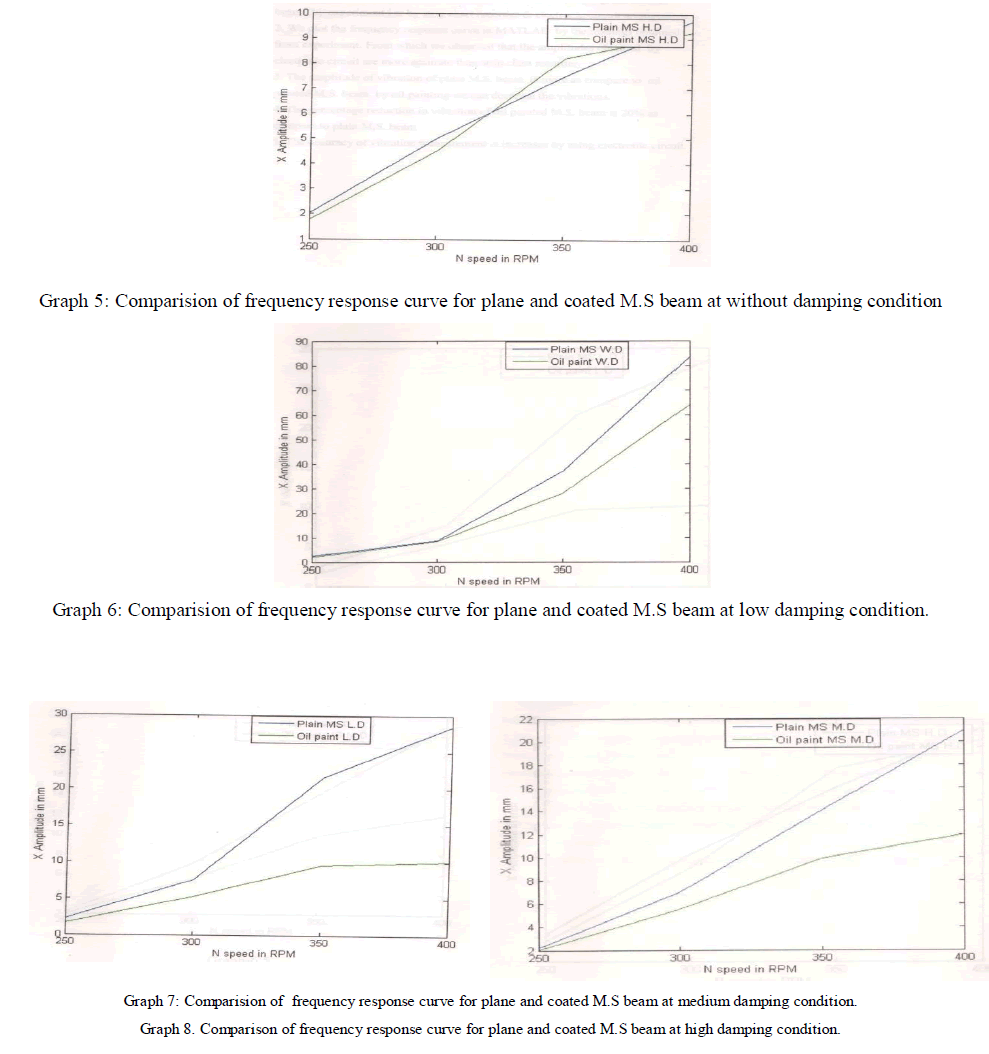 |
2.8 M25 GRADE - FLEXURAL STRENGTHS OF BEAMS (MPa) |
| From the table it is observed that both the concretes are achieving the target strengths at the age of 28 days. But the strengths of normal concrete are slightly higher when compared with Quarry stone dust concrete. The flexural strengths did not show much variation with change in dosage of super plasticiser in normal concrete. |
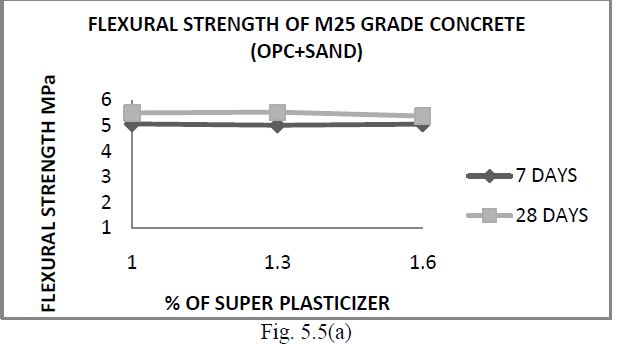 |
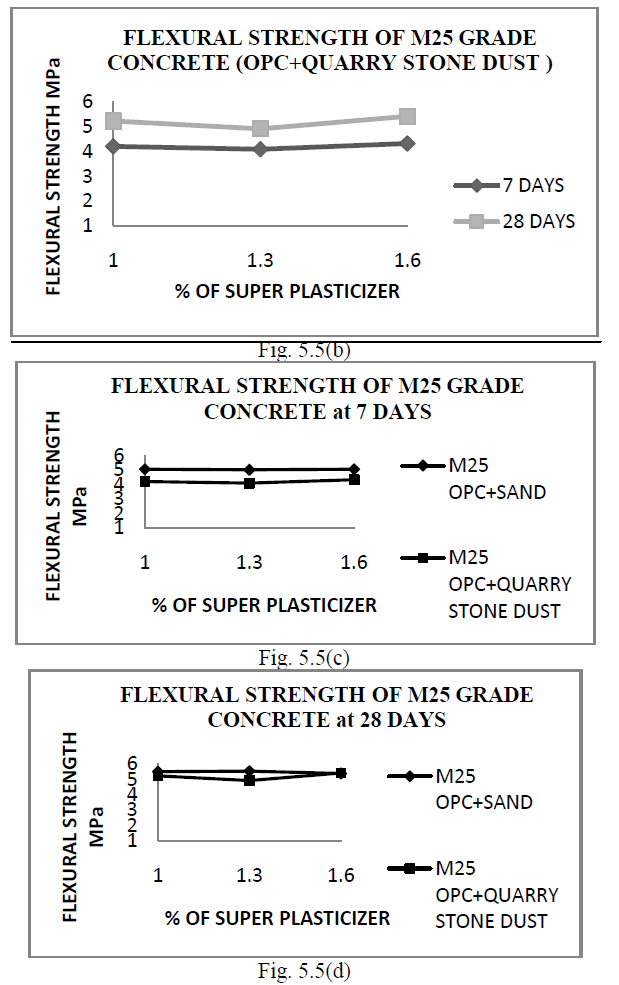 |
IV. CONCLUSIONS |
| From the results tabulated in earlier chapter the following statements can be derived: |
| 1. For the designed mix proportions of M25 and M40 grades of concrete the desired characteristic strengths for cubes are achieved in both conventional concrete and Quarry Stone dust concrete. |
| 2. The strength achieved in concrete made with sand as fine aggregate achieved high strengths when compared with Quarry stone dust concrete. However, in both the cases strengths were falling at a super plasticiser dosage of 1.3% by weight of cement. Similar behaviour was also observed in cubes of M40 grade cubes. |
| 3. In M40 grade cubes it was observed that at 1.3% dosage of super plasticizer the compressive strength is decreased. |
| 4. Flexural strength of M25 prisms when subjected to two-point loading were approximately nearer at various dosages of super plasticiser at 7 days and 28 days for conventional concrete but whereas in QSD concrete at1% dosage of super plasticiser the strength achieved more at 7 days. |
| 5. At 28 days QSD concrete with a super plasticiser dosage of 1.3% by weight of cement exhibits has low strength compared to other dosages. |
| 6. For M40 grade concrete the strength gradually increases for 1% to 1.6% super plasticizer whereas in quarry stone dust the strength decreases from 1% to 1.3% super plasticizer and then increases at 1.6% super plasticizer. |
References |
|